Time to look at another two spectacular snake species! In this Green Tree Python care sheet, you’ll find out why both kinds are great pets and easier to keep than you might expect.
Last updated on February 1st, 2023 at 09:42 am
Green Pythons are unique arboreal snakes, that blend in perfectly in their natural habitat of tropical rainforests. To care for them in captivity we have to replicate a couple of aspects from this lifestyle – namely a good perch and correct humidity levels. Asides from this, looking after them is easier than you might think.
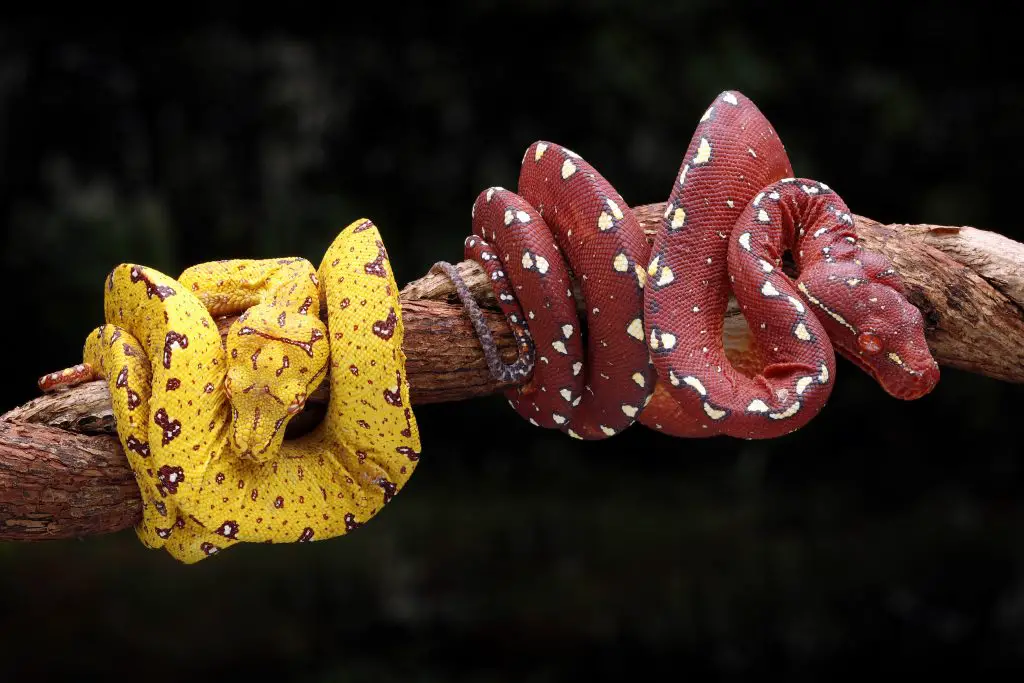
Don’t believe the myths!
Green Tree Pythons (Morelia viridis and Morelia azurea) are two of the world’s most beautiful snake species, yet their popularity as pets has been slow to take off. Previously, one reason was of course that captive bred snakes were few and far between.
This was a major problem a few years back, but captive bred babies are now slowly becoming available on a more consistent basis. Yet people still tell me things like: “I love Green Tree Pythons but don’t want the hassle of keeping one”.
The reason for this is simple. At some point, a huge myth about these species developed and stuck to them like glue. Namely, that they were aggressive and impossible to handle. At the same time, a second myth developed that Green Tree Pythons need misting every day and will drop dead at the slightest drop in humidity.
Given that most pythons are chilled out and very hardy, these myths always seemed strange to me. So, to clear things up, I got in touch with Mark Harris; a local breeder and one of the only people in the UK to produce captive born Manokwari locality Green Tree Pythons.
As you’ll find out from the information he has provided, both myths are completely baseless!
Much of the information in this care sheet relies on Mark’s experience, and many of the photos have also been contributed by him. This is part of an ongoing effort by this website to collaborate with the reptile keeping community as much as possible.
If you’d like to see what Mark has available, you can go to his Morphmarket store here.
Green Tree Python for Sale
At this time, Morphmarket is the best place to look for Green Tree Pythons. Breeders are all subject to feedback and ratings, making this site your safest option.
As with any tropical reptile species, buying wild-caught is a bad idea. You might get one at a lower price, but you’ll also get a lot of extra work and cost. Veterinary help for de-worming and immediate treatment for ectoparasites and dehydration are reason enough for me to steer clear of wild-caught animals!
Fortunately, Green Tree Pythons are now available as captive bred hatchlings in Europe, Asia, and North America. The drawback being that they are still produced in limited numbers, however.
This factor does tend to keep prices relatively high. In the UK, for example, prices can range from £450 to £1000. In the US they can range from $500 to $1200, but unusual individuals can fetch as much as $4500!
Description
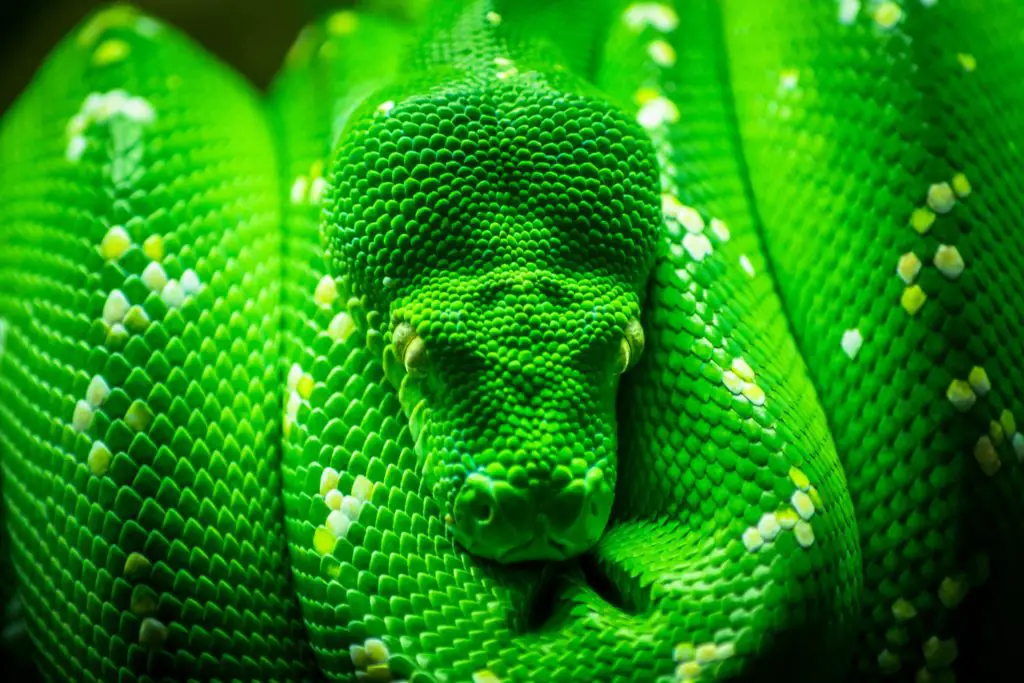
Though more research will undoubtedly follow, taxonomists concluded in a 2020 study that Green Tree Pythons comprise two genetically distinct species. One is found in the northern half of New Guinea and is called Morelia azurea, whereas the other is found to the south and called Morelia viridis.
As with tall taxonomic conclusions this is subject to change! In fact, either species may be divided into more species or subspecies in the future.
Both species vary considerably across their range and branch into several “localities” as we call them in the pet trade. Localities are simply areas of provenance where Green Tree Pythons have a colour or size that distinguishes them from other populations. Localities are not the same as species!
Most adults of both species are a nice, lime green colour with an irregular dorsal stripe that is either white or yellow. In some localities, the dorsal stripe can even be blue. The belly is generally white or yellow.
As in many snake species, ontogenetic shift occurs, with babies starting out yellow, red or deep maroon and changing to green by the time they’re 24in (30cm) long.
You may notice I mentioned localities earlier. In this species localities are mostly separated by geographical features like mountains and rivers which allow significant variation between them. In essence, localities vary greatly in appearance, much like morphs do in Ball Pythons.
So far, around 20 localities are known to hobbyists, though the Biak locality is the most common in captivity.
Blue Green Tree Python (Cyclops locality)

One very sought-after locality is the Cyclops. These get their name from the Cyclops Mountain range in western Papua, Indonesia, from whence they originate. Cyclops Green Tree Pythons are in fact Morelia azurea.
Though their colouration is highly variable, some of them do have an intense, sky blue colour. This is incredibly beautiful and is what gave rise to their scientific name of azurea, which is Latin for deep blue.
Green Tree Python Size
Green Tree Python hatchlings are relatively small when compared to those of true pythons (i.e. belonging to the genus Python). This is probably because the species lays a large number of eggs for its size, usually around 20.
Upon leaving the egg, they are generally about 8 or 9 inches (20-23cm) long and quite thin. At this age they do look quite delicate, but like all pythons grow quickly, reaching adult size within three years.
As adults they are a medium sized species, mostly around the 4ft-5ft (1.2-1.5m) mark. 6ft (1.8m) individuals do occur, and there are credible reports of 7ft+ (2.1m+) females.
Overall, some localities are larger than others, with Manokwaris being smaller than Biaks, for example.
Weight is variable, and females are generally a little heavier than males. Most adults fall between 1000 to 2000 grams.
Green Tree Python Habitat

Green Tree Pythons originate from equatorial rainforest and lowland forest of the Island of New Guinea and the Cape York peninsular, Australia. This habitat is home to some of the least explored forests in the world, boasting a mix of ancient and unusual species.
Being highly specious, this region is of course home to many species of predatory birds, lizards, and mammals. It is this highly competitive environment that has led to Green Tree Pythons developing their cryptic colouration. After all, blending in is a great defence mechanism!
Though the habitat there is undoubtedly rainforest, not all of it is quite as steamy as on TV. In fact, parts of New Guinea regularly experience drought and dry periods.
Nonetheless, in my experience, rain does occur almost daily in this part of the world and the humidity level is usually around 75-80%. This is similar to Indianapolis, for example.
Green Tree Python Enclosure
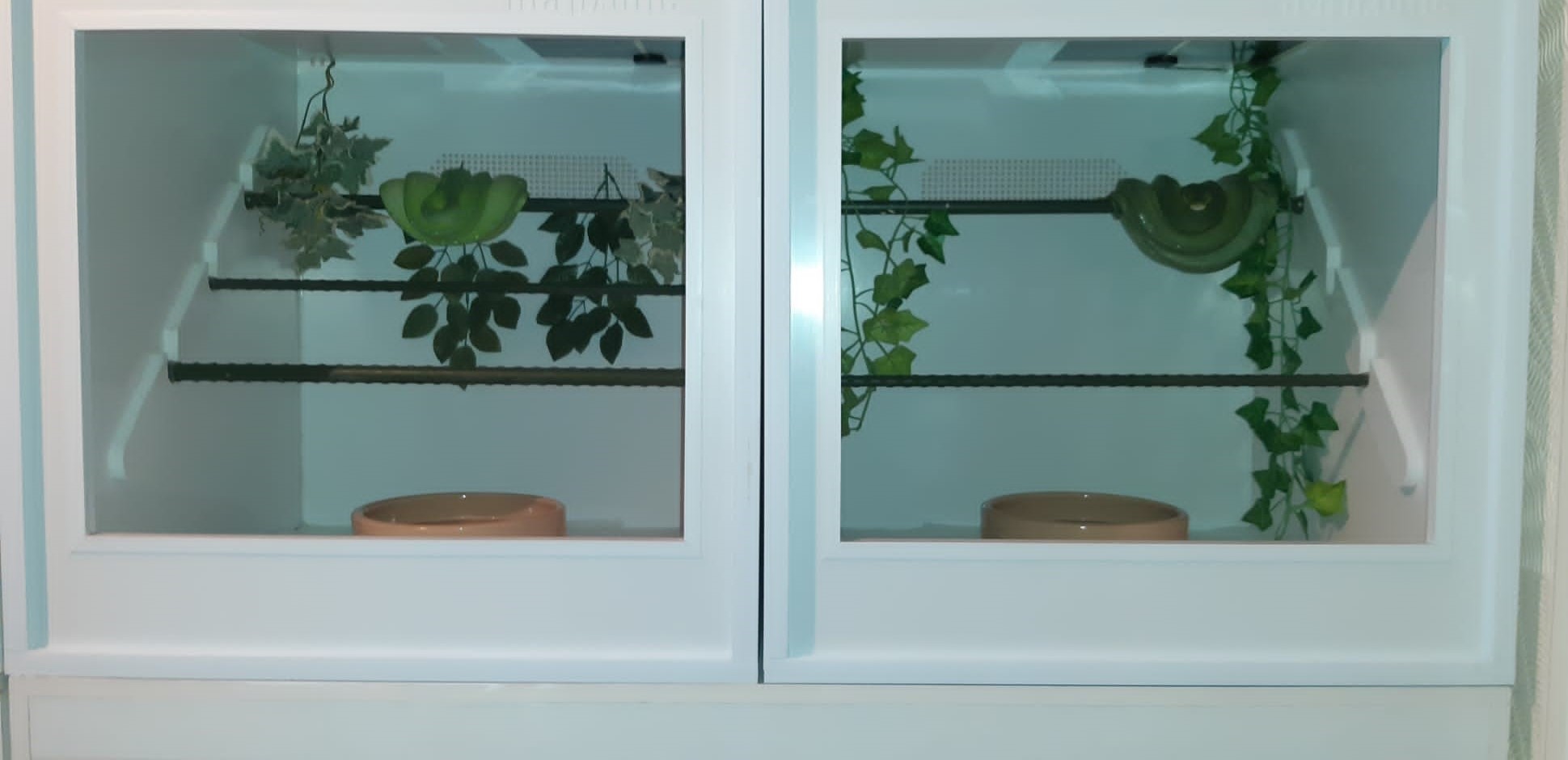
When designing an enclosure, you need to remember one important point: the perch is everything! To be happy, a Green Tree Python of any age needs at least one perch to sit on. This can be made from treated wood or plastic pipes, so long as it is round and allows them to coil up as if on a branch.
For babies, plastic tubs work very well if fitted with a perch or plastic fencing (there’s a photo of this in the diet section of this care sheet) . They are also cheap and easy to upgrade.
For adults, enclosures don’t have to be huge, despite their arboreal nature. 2ft (60cm) wide by 3 or 4ft (90-120cm) high is generally fine. In fact, if you make them too tall, it can discourage the snake from going down to their water bowl to drink.
Personally, I recommend PVC enclosures. These come in an array of different sizes, and easily maintain good humidity. Although previously very expensive, enclosures of this type are now becoming widely available at more reasonable prices.
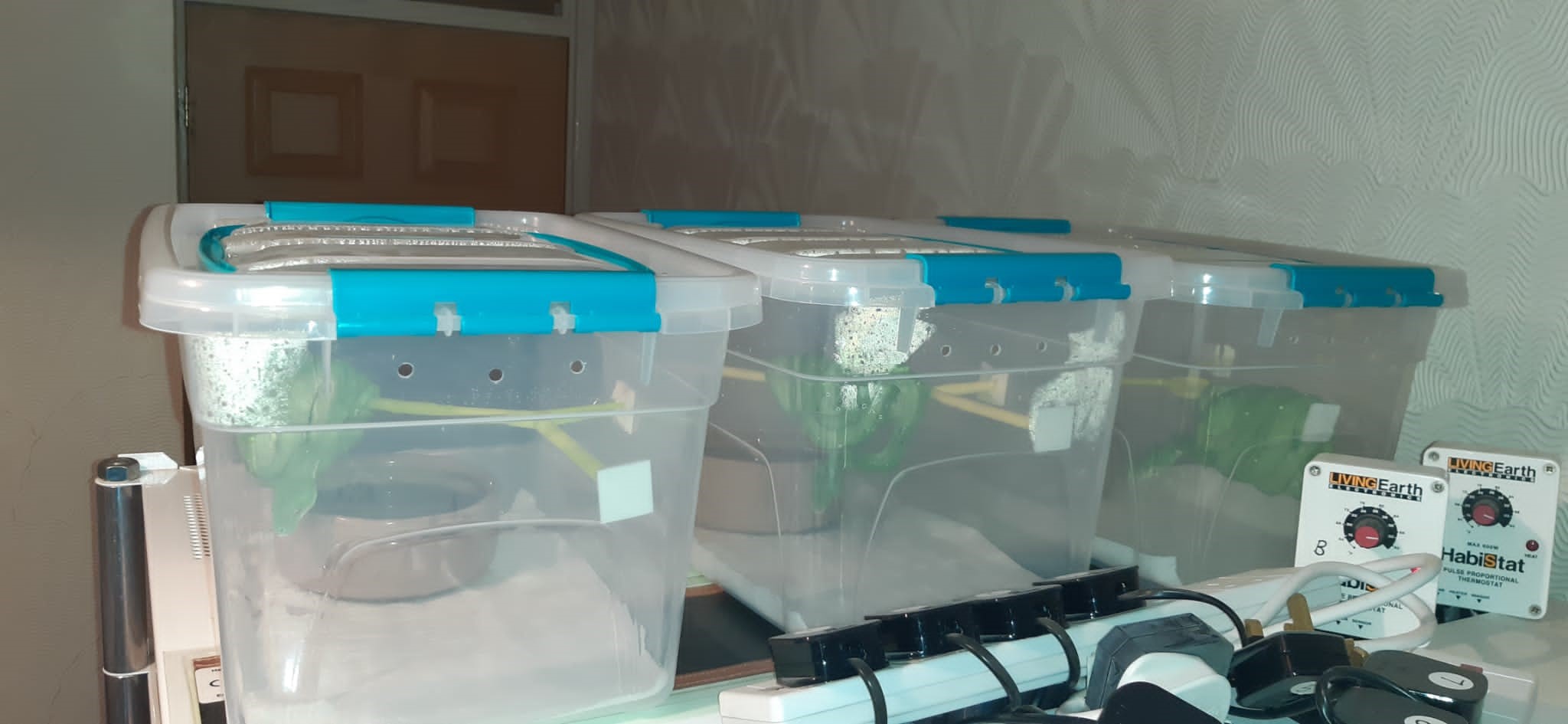
Substrate
It really doesn’t matter too much for this species as they won’t spend much time on it! Cocoa coir, orchid bark, cocoa chips, and cypress mulch all look good in a naturalistic enclosure.
The drawback with these is that they are susceptible to mould if left undisturbed for too long. I would recommend completely changing them once every month to prevent excessive microbial growth.
If you’d rather use something easier and more hygienic, paper towels work just fine and are also great at holding humidity.
Cedar and pine shavings are toxic to Green Tree Pythons so do not use them.
Enclosure hygiene
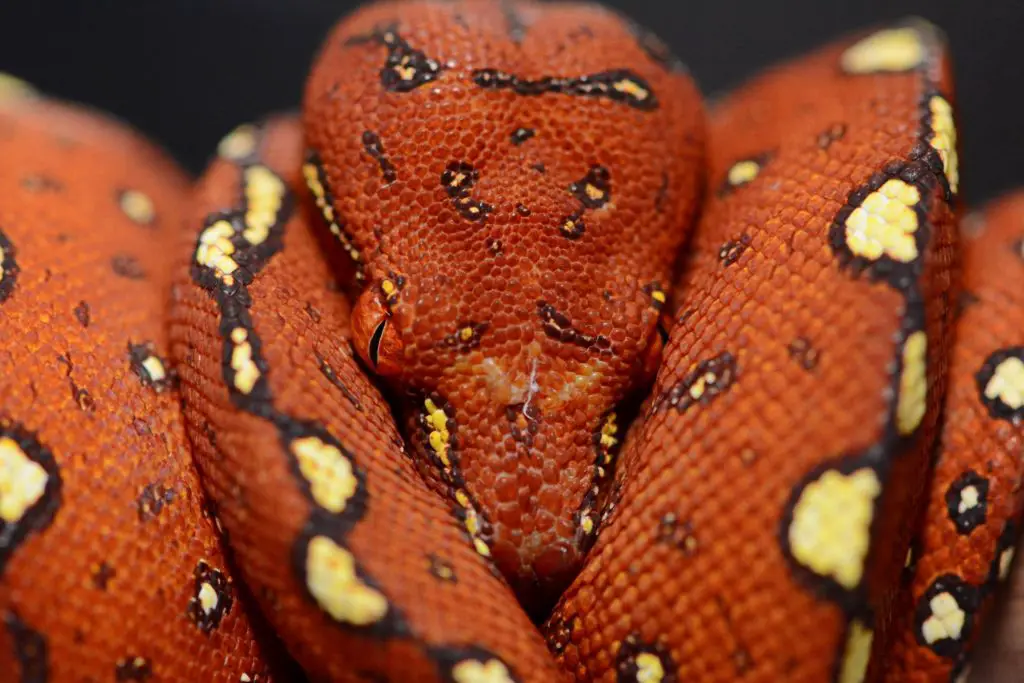
As with any species that enjoys high humidity, germs will quickly become a problem if hygiene standards aren’t high. This can lead to health issues like respiratory infections, scale rot, or protozoan infections.
Spot clean each time the animal defecates or urinates, and clean the whole enclosure with a veterinary approved disinfectant each time you do a complete substrate change. Here in the UK many of us use F10 Veterinary disinfectant, but it isn’t always easy to find in the US.
Fortunately, there are several alternatives (too many to list quickly here) – but whichever product you choose make sure it is tried and tested by experienced keepers.
Heating and temperature
Provide a basking area at 85-88f (29-31c), an ambient air temperature of 80-82f (26.7-27.7c) and a night-time drop of 5-8f (3-4.5c).
Temperatures need to be stable, year-round given the tropical origins of Green Tree Pythons. Don’t forget that some thermostats have a night-time setting that allows you to program the nightly drop.
For heating, ceramic heat emitters are the worst option. They simply get too hot and dry out the air.
Radiant heat panels are better, but overall, high-capacity heat pads (as seen in the photos) are the best and safest option. These are safe to use without a cover and give nice, constant heat. Placement should be on the ceiling of the enclosure, to one side.
If using a heat panel or heat pad, it is best to use a pulse-proportional thermostat rather than an on/off or dimming model.
Place the thermostat probe near the perch in the basking area, so that it gets a good reading of what the panel or pad is putting out. In addition, always use a digital thermometer probe or temperature gun to measure the temperature in the same spot. This will allow you to adjust the thermostat as necessary.
For measuring ambient air temperature, use a separate digital thermometer, with its probe placed in the upper half of the enclosure, but away from the heat source.
For juveniles in tubs a normal heat pad attached to the outside of the bottom of the enclosure works well. Place the thermostat probe between the mat and the bottom of the tub, but don’t forget to use a digital thermometer probe to measure air temperature inside the tub.
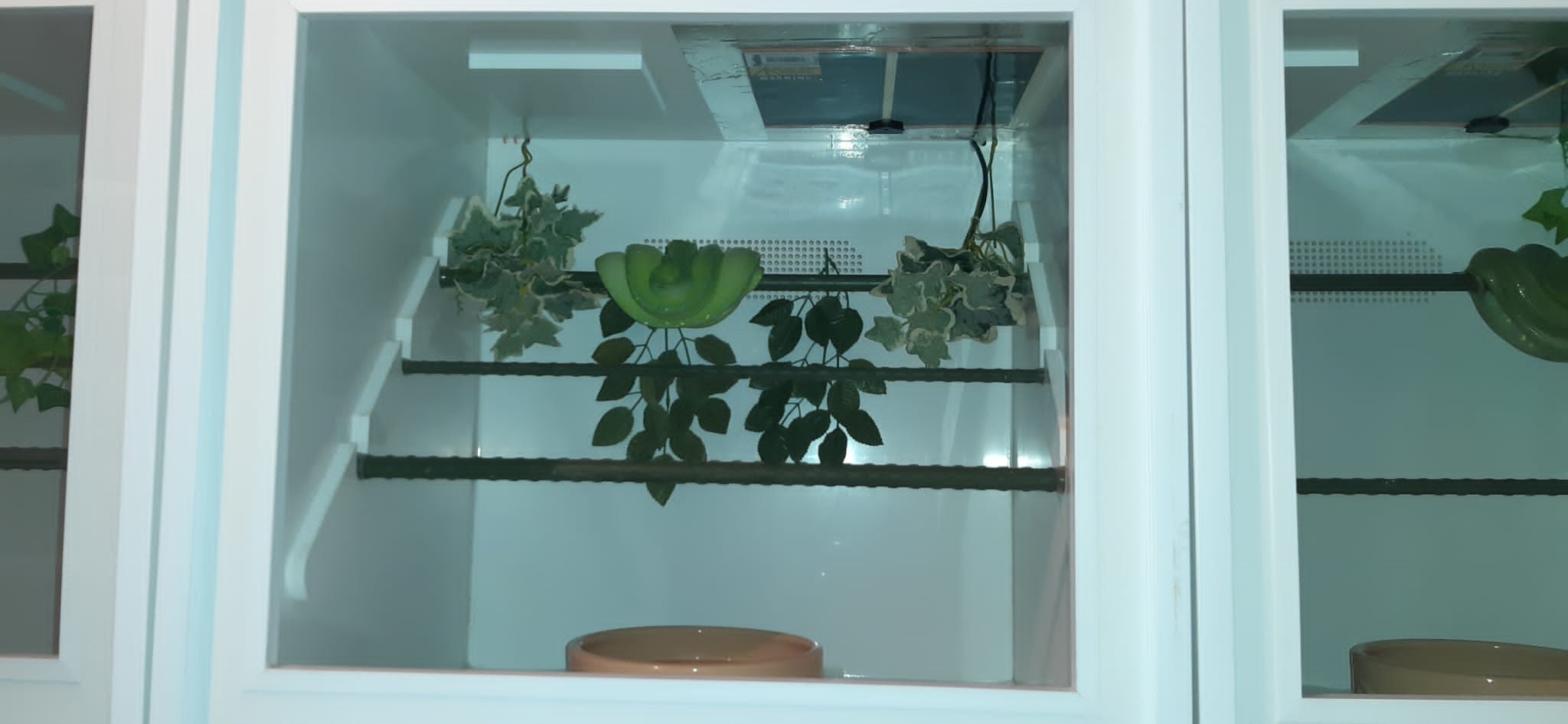
Water and humidity
Contrary to popular belief, this species will drink from a bowl. Always provide a decent sized bowl of fresh water, changing it every few days.
Green Tree Pythons obviously come from a very humid environment. Nonetheless, you do have to lower the humidity a tad in captivity. In your house, there simply isn’t the same level of ventilation as in the great outdoors. Don’t forget that constant wet conditions lead to insanitary housing!
My advice is: do not spray them constantly. They’ll be just fine with a nice 70% humidity level and are just as susceptible to respiratory and skin infections from excessive humidity as other species.
When it comes to shedding, this is a different scenario and it is perfectly fine to spray them in the days leading up to a shed so that it goes smoothly.
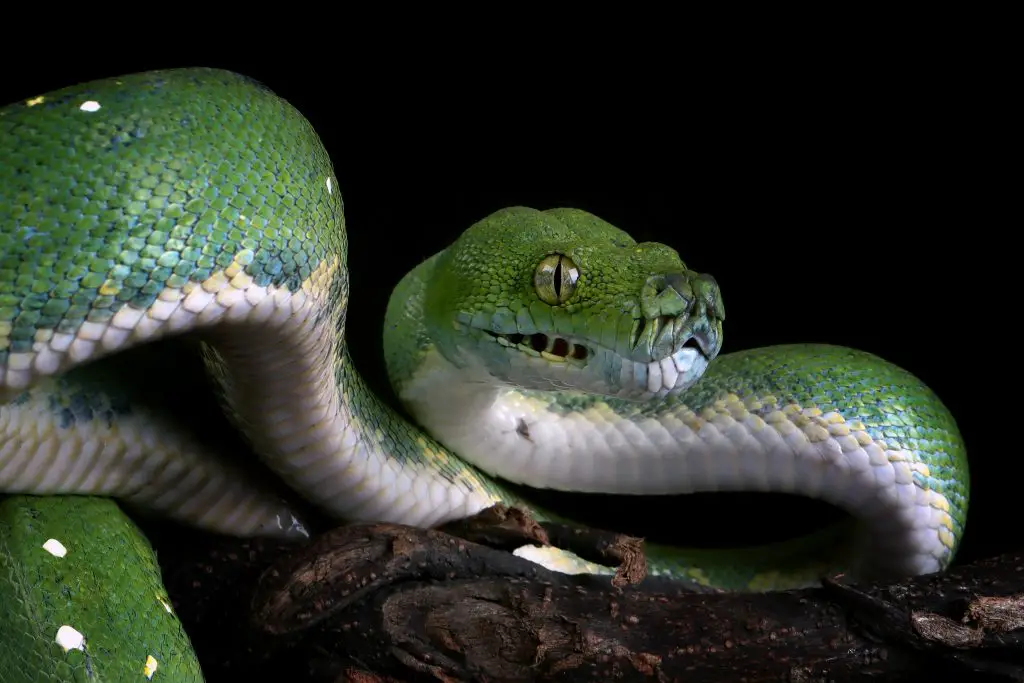
Lighting
As I mention earlier, water abundance and weather can vary in parts of their range. Conversely, daylight hours never do!
On the equator the sun rises at 6am and sets at 6pm, all year round. This means that to keep Green Tree Pythons happy in captivity they need constant hours of daylight. Being nocturnal, this helps them know when to sleep and when to hunt.
As you may have guessed, this nocturnal nature also means that they are perfectly capable of metabolising Vitamin D from their food – no UVB lighting is necessary. It’s your choice whether to include it.
The snakes won’t care, they just want to know what time of day it is. Light through your window or ambient lighting in the room is just fine
What I would say is that in a highly decorated set up UVB will make the snake and enclosure look great.
What do Green Tree Pythons eat?
In the wild these snakes eat a little bit of everything. Birds, mammals, lizards and even frogs are ambushed from their perch. They simply pick a good spot to sit and wait for whatever passes within striking distance.
If the prey isn’t quite close enough, they will also try to lure it towards them by wriggling their tail. This behaviour is called caudal luring and has been observed in several snake species.
Though they eat a bit of everything in the wild, the presence of thermoreceptive pits in their labial scales suggests that warm blooded prey is their main target.
This is supported by the fact that in captivity they seem to do best when fed a diet of mice as juveniles and rats as adults.
Start hatchlings on pinkie mice, then gradually upgrade to adult mice as they approach adulthood. In general, breeders feed hatchlings every 5 to 7 days.
Once adult, switch to small rats, or give them two or more large mice at each meal if they refuse.
Don’t forget that as ambush predators Green Tree Pythons do a lot of sitting around. They have a slow metabolism and are therefore prone to obesity. I would not recommend feeding adult Green Tree Pythons more than once every 10-14 days.

Green Tree Python Handling
Now we’re getting to the scary part, handling the ferocious Green Tree Python! Just kidding. As a reptile enthusiast, I’m sure you know by now that not everything you hear about snakes is true!
Though the whole aggressive Green Tree Python myth has stuck in place, it is completely unwarranted. Green Tree Pythons are every bit as handleable as other pythons. From my observations, they can be very shy and gentle creatures.
With gentle handling once or twice a week, you can easily raise a hatchling into a tame adult. Don’t restrain them or rush them, just let them climb through your fingers and explore for a while, it’s as simple as that!
My only reticence is that given their shyness it is possible they could become stressed with over-handling. To avoid this, I would keep handling to a five minute session at most.
Lifespan
In general, this species lives between 12 and 20 years in captivity, with one individual apparently reaching 35.
This doesn’t sound too impressive when compared to Ball Pythons which have been known to live more than 50 years. Notwithstanding, it’s important to consider two things: there are many, many more Ball Pythons in captivity around the world than there are Green Tree Pythons, and we’ve been keeping them for much longer.
We may find in years to come this species can live just as long as Ball Pythons, we just don’t know it yet.
For now, I’m going to say that 15-20 years is a good lifespan for a captive Green Tree Python.
Are Green Tree Python’s good pets?

I can confidently say that Green Tree Pythons make great pets. In fact, I think their popularity and availability will continue to grow.
We’ve all heard the myths, but thanks to Mark’s input we now know for sure that they aren’t true! Rather than being aggressive, fragile captives, Green Tree Pythons are in fact calm, hardy pets when kept correctly.
All you need to do is get a few things right. They must have a perch, the correct temperature and photoperiod, and be kept in sanitary conditions.
All in all, the only real drawback with this species is that it is still expensive compared to others like Milk Snakes and Boa Constrictors.
The best way to counter this is of course to refuse to buy wild-caught animals and support breeders by buying captive bred snakes. Doing this will eventually increase availability and drive down prices.
Hopefully, this care sheet has given you some insight into why Green Tree Pythons have made it onto this website. As always, comment or get in touch for more advice.
Green Tree Python care Summary
| Temperature: | Basking area 85-88f (29-31c), ambient air temperature 80-82f (26.7-27.7c) , night-time drop of 5-8f (3-4.5c). |
| Humidity: | 70%. Spraying not necessary, but allow snake to dry out fully between sprays if you do use this method |
| Favourite food: | Mice and rats |
| Enclosure size: | 12in (30cm) for hatchlings. 2-3ft (60-90) wide by 3-4ft (90-120cm) tall for adults |
| Activity rythm: | Nocturnal |
| Lighting needs: | UVB not necessary but can enhance a naturalistic set up |

Key points to remember
- Captive-bred Green Tree Pythons can live a long time if given the proper care: they are not as fragile as previously thought! Just like other snakes, they thrive with a temperature gradient (both a warm side and a cool side in their enclosure), appropriate prey items, and the correct humidity level.
- This species of snake has a slender, prehensile tail for gripping tree branches. Make sure your pet is able to use it! A good perch is the most important thing to get right in a GTP enclosure. You don’t necessarily need live plants or a naturalistic setup, but your snake must be able to rest on a perch that replicates a horizontal branch.
- Green Tree Pythons do not need UV light, but they do need light to regulate their circadian rythm. Always provide some kind of light in the room, whilst making sure not to expose the enclosure to direct sunlight.
- Contrary to popular belief, these snakes will drink from a bowl. Always provide them with clean water, in a medium to large water bowl. (This will also help regulate the ambient humidity)
- For a juvenile python, try using a smaller enclosure. Small plastic tubs, for example, are better at maintaining good temperatures and humidity levels than larger setups.
